ESD测试与整改设计参考
- 格式:ppt
- 大小:1.32 MB
- 文档页数:27
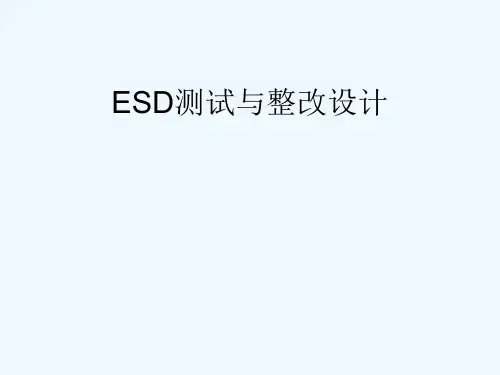
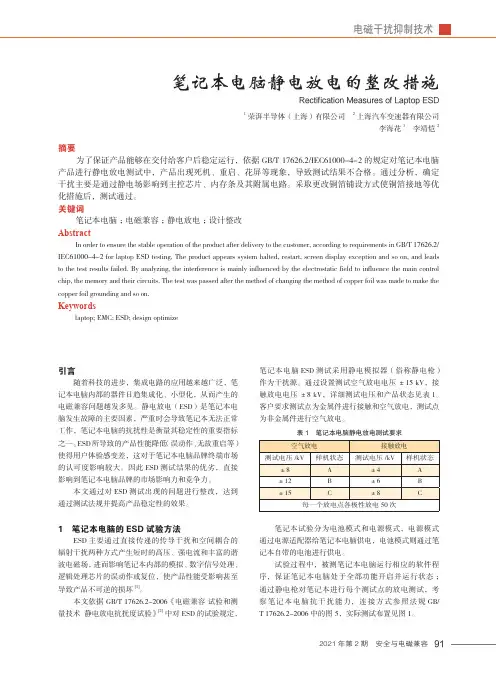
电磁干扰抑制技术912021年第2期 安全与电磁兼容引言随着科技的进步,集成电路的应用越来越广泛,笔记本电脑内部的器件日趋集成化、小型化,从而产生的电磁兼容问题越发多见。
静电放电(ESD)是笔记本电脑发生故障的主要因素,严重时会导致笔记本无法正常工作,笔记本电脑的抗扰性是衡量其稳定性的重要指标之一。
ESD 所导致的产品性能降低(误动作、无故重启等)使得用户体验感变差,这对于笔记本电脑品牌终端市场的认可度影响较大。
因此ESD 测试结果的优劣,直接影响到笔记本电脑品牌的市场影响力和竞争力。
本文通过对ESD 测试出现的问题进行整改,达到通过测试法规并提高产品稳定性的效果。
1 笔记本电脑的ESD 试验方法ESD 主要通过直接传递的传导干扰和空间耦合的辐射干扰两种方式产生短时的高压、强电流和丰富的谐波电磁场,进而影响笔记本内部的模拟、数字信号处理、逻辑处理芯片的误动作或复位,使产品性能受影响甚至导致产品不可逆的损坏[1]。
本文依据 GB/T 17626.2-2006《电磁兼容 试验和测量技术 静电放电抗扰度试验》[2]中对ESD 的试验规定,笔记本电脑ESD 测试采用静电模拟器(俗称静电枪)作为干扰源。
通过设置测试空气放电电压±15 kV,接触放电电压±8 kV,详细测试电压和产品状态见表1。
客户要求测试点为金属件进行接触和空气放电,测试点为非金属件进行空气放电。
笔记本试验分为电池模式和电源模式,电源模式通过电源适配器给笔记本电脑供电,电池模式则通过笔记本自带的电池进行供电。
试验过程中,被测笔记本电脑运行相应的软件程序,保证笔记本电脑处于全部功能开启并运行状态;通过静电枪对笔记本进行每个测试点的放电测试,考察笔记本电脑抗干扰能力,连接方式参照法规GB/ T 17626.2-2006中的图5,实际测试布置见图1。
摘要为了保证产品能够在交付给客户后稳定运行,依据GB/T 17626.2/IEC61000-4-2的规定对笔记本电脑产品进行静电放电测试中,产品出现死机、重启、花屏等现象,导致测试结果不合格。

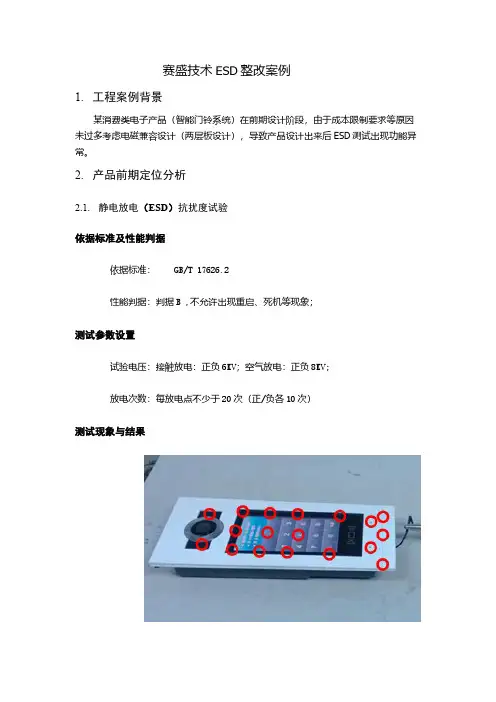
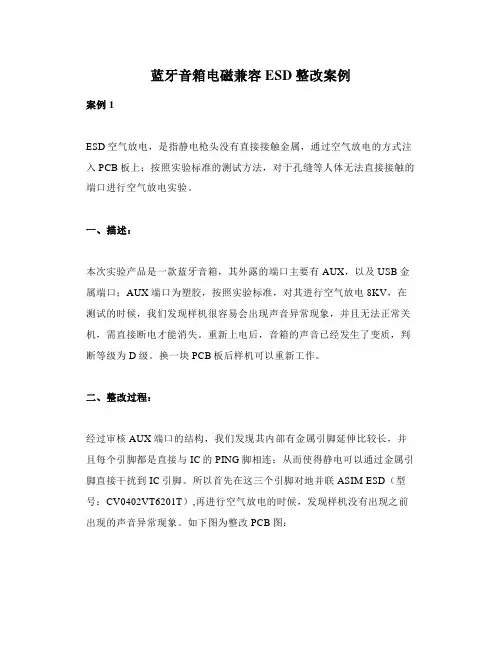
蓝牙音箱电磁兼容ESD整改案例案例1ESD空气放电,是指静电枪头没有直接接触金属,通过空气放电的方式注入PCB板上;按照实验标准的测试方法,对于孔缝等人体无法直接接触的端口进行空气放电实验。
一、描述:本次实验产品是一款蓝牙音箱,其外露的端口主要有AUX,以及USB金属端口;AUX端口为塑胶,按照实验标准,对其进行空气放电8KV,在测试的时候,我们发现样机很容易会出现声音异常现象,并且无法正常关机,需直接断电才能消失。
重新上电后,音箱的声音已经发生了变质,判断等级为D级。
换一块PCB板后样机可以重新工作。
二、整改过程:经过审核AUX端口的结构,我们发现其内部有金属引脚延伸比较长,并且每个引脚都是直接与IC的PING脚相连;从而使得静电可以通过金属引脚直接干扰到IC引脚。
所以首先在这三个引脚对地并联ASIM ESD(型号:CV0402VT6201T),再进行空气放电的时候,发现样机没有出现之前出现的声音异常现象。
如下图为整改PCB图:再此也设计出一般AUX的静电以及EMI防护方案:案例2一、ESD放电分析:在ESD放电的过程中,会产生瞬间的高电压,大电流和宽带的电磁干扰,以至于电子组件失效、损坏、降低可靠度,大至电子系统设备误动作、损毁,甚至会酿成重大灾难。
二、整改前实验现象:此次实验对象是一款多功能蓝牙音箱,其有AUX、蓝牙、USB、TF卡等模式。
在蓝牙模式充电的情况下,设备在进行空气±8KV放电的时候,机器会出现断蓝牙,复位的现象。
三、整改过程:由于对音箱进行接触放电的时候,发现音箱不会出现类似现象;于是先将PCB板的地定义为完整地;只要将静电导到地上就行;所以第一步措施为:将AUX信号线上串上磁珠(ASIM型号:CVB1005C152T)并且对地并联ESD器件(ASIM型号:CV0402VT6201T),如下图:其基本原理为:整改好后,重新对音箱进行空气±8KV测试,发现现象有所改善,但是还是没有彻底根除。

防静电国家标准及资料一、国家标准(GB,GB/T,GBJ)•GBJ 79-1985 工业企业通信接地设计规范•GB 6951-1986 轻质油品装油安全油面电位值•GB/T 6833.3-1987 电子测量仪器电磁兼容性试验规范静电放电敏感度试验•GB/T 11210-1989 硫化橡胶抗静电和导电制品电阻的测定•GB 12014-1989 防静电工作服•GB/T 1410-1989 固体电工绝缘材料体积电阻率及表面电阻率试验方法•GB 12158-1990 防止静电事故通用导则•GB/T 12582-1990 液态烃类电导率测定方法( 精密静电计法)•GB/T 12703-1991 纺织品静电测试方法•GB 13348-1992 液体石油产品静电安全规程•GB/T 14288-1993 可燃气体与易燃液体蒸气最小静电点火能测定方法•GB/T 50174-1993 计算机机房设计规范•GB 4385-1995 防静电鞋、导电鞋技术要求•GB/T 15463-1995 静电安全名词术语•GB/T 6539-1997 航空燃料与馏分燃料电导率测定法•GB/T 2439-2001 硫化橡胶或热塑性橡胶导电性能和耗散性能电阻率的测定•GB/T 2887-2000 电子计算机场地通用规范•GB 6950-2001 轻质油品安全静止电导率•GB 4655-2003 橡胶工业静电安全规程二、国家军用标准(GJB)•GJB/Z 25-1991 电子设备和设施的接地、搭接和屏蔽设计指南•GJB 1649-1993 电子产品防静电放电控制大纲•GJB 2527-1995 弹药防静电要求•GJB 2605-1996 柔性热密封防静电阻隔材料规范•GJB 3007-1997 防静电工作区技术要求•GJB/Z 86-1997 静电放电防护包装手册•GJB/Z 105-1998 电子产品防静电放电控制手册三、电子行业标准(SJ,SJ/T)•SJ/T 10147-1991 集成电路防静电包装管•SJ 20154-1992 信息技术设备静电放电敏感度试验•SJ/T 10533-1994 电子设备制造防静电技术要求•SJ/T 10630-1995 电子元器件制造防静电技术要求•SJ/T 10694-1996 电子产品制造防静电系统测试方法•SJ/T 11159-1998 地板覆盖层和装配地板静电性能的试验方法国外静电相关标准ESD standardsESD S1.1:1998—Evaluation, acceptance, and functional testing of wrist straps.ESD STM2.1:1997—Resistance test method for electrostatic discharge protective garments. ESD STM3.1:2000—Ionization.ESD SP3.3:2000—Periodic verification of air ionizers.ESD S4.1:1997—Worksurfaces—Resistance measurements.ESD STM4.2:1998—Worksurfaces—Charge dissipation characteristics.ANSI/ESD STM5.1:2001—Electrostatic discharge sensitivity testing—Human body model. ANSI/ESD STM5.2:1999—Electrostatic discharge sensitivity testing—Machine model.ANSI/ESD STM5.3.1:1999—Charged device model (CDM)—Component level.ESD S6.1:1999—Grounding—Recommended practice.ANSI ESD S7.1:1994—Floor materials—Resistive characterization of materials.ANSI ESD S8.1:1993—ESD awareness symbols.ESD S9.1:1995—Resistive characterization of footwear.ESD SP10.1:2000—Automated handling equipment.ANSI ESD S11.11:1993—Surface resistance measurement of static dissipative planar materials. ESD STM11.12:2000—Volume resistance measurement of static dissipative planar materials. ANSI ESD S11.31:1994—Evaluating the performance of electrostatic discharge shielding bags. ESD STM12.1:1997—Seating-resistive characterization.ESD STM13.1:2000—Electrical soldering/desoldering hand tools.ANSI ESD S20.20:1999—Standard for the development of an ESD control program.ESD STM97.1:1999—Floor materials and footwear—Resistance in combination with a person.ESD STM97.2:1999—Floor materials and footwear voltage measurement in combination with a p erson.AFLCR 65-8:1998—Maintenance—Engineering and supply: Electrostatic discharge (ESD) control program.ANSI C63.14:1998—American national standard dictionary for technologies of electromagnetic co mpatibility (EMC), electromagnetic pulse (EMP), and electrostatic discharge (ESD)—Dictionary of EMC/EMP/ESD terms and definitions.ANSI C63.16:1993—American national standard guide for electrostatic discharge test methodologi es and criteria for electronic equipment.ANSI N322:1997—American national standard inspection, test, construction, and performance requ irements for direct reading electrostatic/electroscope–type dosimeters.ANSI T1.308:1996—Central office equipment—Electrostatic discharge immunity requirements. ASQ P672:1996—Auditing ESD and cleanroom processes.ASTM D257-78—Standard test methods for dc resistance or conductance of insulating materials.ASTM D991-83—Standard test method for rubber properties—Volume resistivity of electrically c onductive and antistatic products.ASTM D5077-90:1997—Standard terminology relating to electrostatic discharge (ESD) packaging materials.ASTM E1549-95:2000—Standard specification for ESD-controlled garments required in cleanroom s and controlled environments for spacecraft for nonhazardous and hazardous operations.ASTM F150-98—Standard test method for electrical resistance of conductive and static dissipativ e resilient flooring.ASTM F1812-97a—Standard test method for determining the effectiveness of membrane switch E SD shielding.Bellcore GR-1421-CORE:1995—Generic requirements for ESD-protective circuit packet containers. BS 6654:1985—Method for determination of the electrical resistivity of textile floor coverings.BS EN 100015-2:1994—Basic specification—Protection of electrostatic-sensitive devices—Require ments for low-humidity conditions.BS EN 100015-3:1994—Basic specification—Protection of electrostatic-sensitive devices—Require ments for cleanroom areas.BS EN 100015-4:1994—Basic specification—Protection of electrostatic-sensitive devices—Require ments for high-voltage environments.BS EN 1149-1:1996—Protective clothing—Electrostatic properties—Surface resistivity (test method s and requirements).BS EN 1149-2:1997—Protective clothing—Electrostatic properties—Test method for measurement of the electrical resistance through a material (vertical resistance).BS EN 1718:1999—Light conveyor belts—Test method for the measurement of the electrostatic field generated by a running light conveyor belt.DI-ATTS-80285B:1997—Engineering support data (ESD).DI-RELI-80669:1992—Electrostatic discharge (ESD) control program flag.DI-RELI-80671:1992—Handling procedures for electrostatic discharge (ESD) sensitive items.EIA 471:1980—Symbol and label for electrostatic sensitive devices.EIA 541:1988—Packaging material standards for ESD-sensitive items.EIA 541:1990—Packaging of electronic products for shipment.EIA 545:1989—Electromechanical switch test method for electrostatic discharge (ESD).EIA 625—Handling electrostatic discharge sensitive (ESDS) devices.EIA-JEP 108—Distributor requirements for handling electrostatic discharge sensitive (ESDS) devic es.EOS/ESD EP102:1988—Electrostatic discharge and electronic equipment: A practical guide for de signing to prevent ESD problems.EOS/ESD EP103:1990—ESD program management: A realistic approach to continuous, measurabl e improvement in static control.EOS/ESD EP105:1995—ESD in silicon integrated circuits.ESD 1:2000—General practices for ESD control for MR and GMR heads.IEC 60801-2:1991—Electromagnetic compatibility for industrial-process measurement and control equipment—Electrostatic discharge requirements.IEC 61000-4-2:1995—Electromagnetic compatibility (EMC)—Part 4: Testing and measurement tec hniques—Section 2: Electrostatic discharge immunity test.IEC 61000-4-2:1999—Electromagnetic compatibility (EMC)—Part 4-2: Testing and measurement t echniques—Electrostatic discharge immunity test.IEC 61087:1991—Guide for evaluating the discharges from a charged surface.IEC 61340-1:1998—Electrostatics—Part 1: Guide to the principles of electrostatic phenomena (IE C/101/35/CD).IEC 61340-2-2 TR3:2000—Electrostatics—Part 2-2: Measurement methods—Measurement of charg eability.IEC 61340-2-3:2000—Electrostatics—Part 2-3: Methods of test for determining the resistance and resistivity of solid planar materials used to avoid electrostatic charge accumulation.IEC 61340-3-1:1998—Electrostatics—Part 3-1: Methods for simulation of electrostatic effects—Hu man body model (HBM)—Component testing (IEC/101/33/CD).IEC 61340-3-2:1998—Electrostatics—Part 3-2: Methods for simulation of electrostatic effects—Ma chine model (MM)—Component testing (IEC/101/34/CD).IEC 61340-4-1:1995—Electrostatics—Part 4: Standard test methods for specific applications—Section 1: Electrostatic behavior of floor coverings and installed floors.IEC 61340-4-3:1999—Test method for the characterization of electrostatic protective footwear (IE C document 101/62/CD).IEC 61340-5-1 TR2:1998—Electrostatics—Part 5-1: Protection of electronic devices from electrost atic phenomena—General requirements.IEC 61340-5-2 TR2:1999—Electrostatics—Part 5-2: Protection of electronic devices from electrost atic phenomena—User guide.IEC/PAS 62162:2000—Field-induced charged-device model test method for electrostatic discharge withstand thresholds of microelectronic components.IEC/PAS 62179:2000—Electrostatic discharge (ESD) sensitivity testing human body model (HBM). IEC/PAS 62180:2000—Electrostatic discharge (ESD) sensitivity testing machine model (MM).IEEE C62.38:1994 (R1999)—IEEE guide on electrostatic discharge (ESD)—ESD withstand capabi lity evaluation methods (for electronic equipment subassemblies).IEEE C62.47:1992—IEEE guide on electrostatic discharge (ESD)—Characterization of the ESD e nvironment.ISO/DIS 10605:2000—Road vehicles—Test methods for electrical disturbances from electrostatic discharge.ISO/TR 10605:1994—Road vehicles—Electrical disturbances from electrostatic discharge.JESD 22-A114-B:2000—Electrostatic discharge (ESD) sensitivity testing human body model (HB M).JESD 22-A115-A:1997—Electrostatic discharge (ESD) sensitivity testing machine model (MM).JESD 22-C101-A:2000—Field-induced charged-device model test method for electrostatic discharg e withstand thresholds of microelectronic components.MIL-PRF-87893B:1997—Workstation—Electrostatic discharge (ESD) control.QPL-87893-1:1995—Workstation electrostatic discharge (ESD) control.RAC SOAR 6:1986—ESD control in the manufacturing environment.SAE J551/15:1995—Vehicle electromagnetic immunity—Electrostatic discharge (ESD).。

esd阻抗的检测标准值一、概述ESD(ElectroStaticDischarge)是静电的简称,是一种常见的物理现象,特别是在电子设备中,ESD干扰可能会对电路造成不良影响。
因此,对电子设备的ESD阻抗进行检测和评估是非常重要的。
本文将介绍ESD阻抗的检测标准值及其应用。
二、检测标准值1.电阻率:ESD阻抗的最基本标准值是电阻率。
在理想情况下,ESD电流应该被限制在泄放路径上,而不会对设备造成损害。
电阻率的大小取决于设备表面处理、材料以及工作环境等因素。
一般来说,表面处理工艺越先进、材料越纯正,电阻率就越低。
2.电容率:ESD阻抗还受到电容率的影响。
在静电放电情况下,ESD电流会在导体和大地之间形成一个等效电容,这个电容的大小取决于导体和地之间的距离以及周围环境的介电常数。
因此,为了提高ESD阻抗,需要减小这个电容的大小。
3.分布参数:ESD阻抗还受到分布参数的影响,包括电感、电容和电阻等。
这些参数的大小取决于设备的结构、材料以及工作频率等因素。
因此,在检测ESD 阻抗时,需要考虑到这些因素。
三、检测方法1.模拟测试:使用静电发生器对电子设备进行模拟测试,通过测量静电放电时的电压和电流来评估ESD阻抗。
这种方法需要一定的专业知识和技能,需要使用专门的测试设备和仪器。
2.实际应用测试:在实际应用中,通过观察电子设备在ESD干扰下的表现来评估ESD阻抗。
这种方法需要有一定的实践经验和对电子设备的了解。
四、应用ESD阻抗的检测标准值在电子设备的设计、生产和维护中都有重要的应用。
首先,它可以帮助设计人员优化电子设备的结构和材料,提高ESD防护能力。
其次,它可以帮助生产人员评估电子设备的品质和性能,确保其符合标准要求。
最后,它可以帮助维护人员及时发现和解决ESD问题,保证电子设备的正常运行。
总之,ESD阻抗的检测标准值是评估电子设备ESD防护能力的重要指标,需要对其进行科学合理的评估和应用。
只有掌握了这些标准值及其应用方法,才能更好地保证电子设备的正常运行和使用安全。
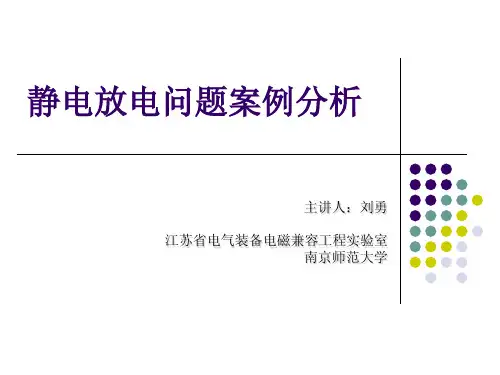
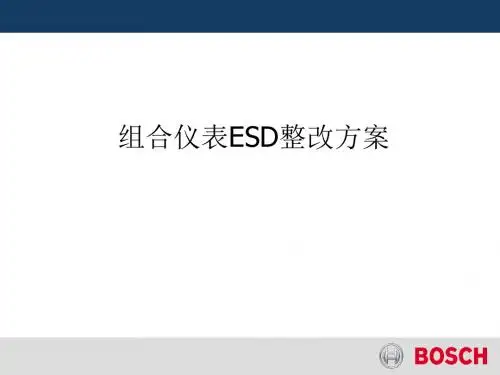
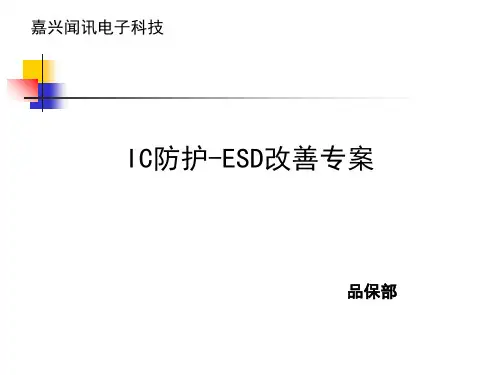
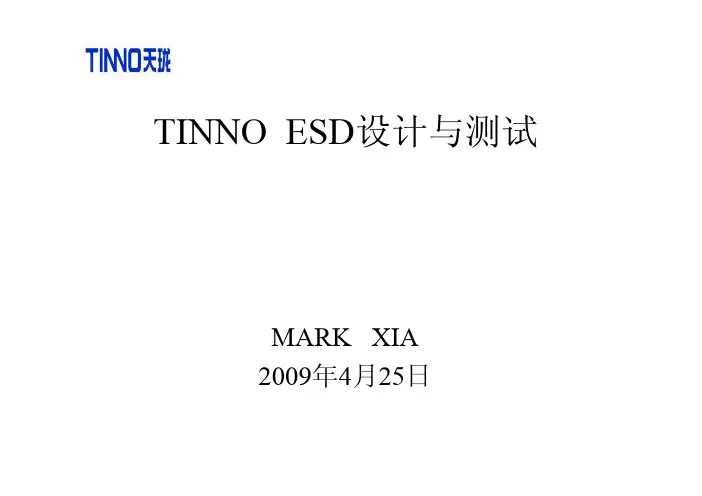
静电,是大家都非常熟悉的一种自然现象,在我国的北方,人们在脱外套或毛衣的时候,经常会听到一些噼里啪啦的声音,有时带着火花,其实,这就是人体身上所携带的静电。
静电会给人们的生活带来种种不便,有时甚至会对人们的生命财产安全造成巨大的危害。
因为, 静电通常产生的都是接近上万伏的高压,甚至几十万伏。
试想一下,如果在航空航天的微电子行业出现这种静电,它对其中某一个电路芯片损坏所造成的后果,那将是不堪设想的。
静电所带来的危害性已引起了各界广泛的关注,为了保护生命及国家财产的安全,国家出台了相应的法规条例,规定由相应的检测机构去执行检测任务。
既然消除静电的发生是几乎不可能的事情,那么人们可以通过在实验室检测物体抗静电的能力,以此来判断静电抗扰度,在这里,我们将为大家重点介绍在手机进网测试中,实验室静电抗扰度ESD测试的相关内容。
静电抗扰ESD是手机进入各国市场的一个必测项目,也是厂家最为担心的问题之一。
下面我们先来了解一下静电靠扰测试(ESD)是如何进行测试的:(一)测试方法1. 严酷度等级:接触放电:+2KV -2KV,+4KV-4KV空气放电:+2KV-2KV,+4KV-4KV,+8KV-8KV2.对被测设备的监视:专用模式:被测移动电话与无线综合测试仪建立并保持通讯连接,在加扰的过程中,观察被测移动电话机是否维持通信连接。
整个加扰过程结束后,观测被测移动电话机是否仍能保持通信连接,是否能正常工作,有无用户可察觉的通信质量的降低,有无用户控制功能的丧失或存储数据的丢失。
空闲模式:观察发信机是否误操作。
实验结束后,观测被测移动电话机是否仍能保持通信连接,是否能正常工作,有无用户可察觉的通信质量的降低,有无用户控制功能的丧失或存储数据的丢失。
3.测试条件与结果:(二)应对整改措施目前在手机的静电靠扰测试(ESD)中经常出现问题的地方有如下九处:1:Receiver2:麦克风MIC3:键盘4:喇叭Speaker5:金属饰件6:电池后盖7:侧键及USB口8:显示屏9:中间缝隙,滑盖缝隙等在对手机ESD出现问题的整改过程中,大致可采用以下两种办法:1.导:就是用导电胶带导电泡棉或者铜箔,将静电引入GND。
1.目的:建立公司内部各项静电防护项目的测试规范,统一防静电测试方法与判定标准。
2.范围:适用于本公司静电防护项目的检测,如:接地系统、防静电地板(地垫)、防静电工作台(桌垫)、周转箱、包装袋、防静电手环、人体静电防护用品、离子风机、烙铁等辅助工具。
3.内容:3.1静电手环:3.1.1测试仪器:静电手环测试仪3.1.2测试方法:图1-1 静电手环测试示意图 3.1.2.1来料检验时进行抽样测试,并记录于《静电手环测试记录表》。
3.1.2.2静电手环由IQC 进行抽样测试。
3.1.2.3必须将腕带扣反面金属接触到手腕时,才能进行测试。
3.1.2.4测试时,腕带扣住一只手,另一端香蕉头插入测试器上的测试端子。
3.1.2.5测试者用手指按下导通器上金属键,看导通器上灯号显示,如图1-1:① 绿灯GOOD 亮-OK ,且BUZZER 长鸣。
② 黄灯LOW 、红灯HIGH 亮-失败,BUZZER 无声(需更换腕带或腕带线再测试)。
3.1.2.6且于测试中增加摆动手腕的动作,以确认是否有接触不良。
3.1.2.7测试中若发生有两个灯号同时亮时(绿、黄灯亮或绿、红灯亮),应更换新品或其他良品腕带(腕带或腕带线)再测。
(a )若灯号显示正常,则确认腕带部份不良应更换。
(b )若灯号依然显示两个灯亮,或者时好时坏,判定可能测试器为不良品,应立即通知组长处理,将该测试器重新校验或送修。
3.1.3测量频率:来料检验(抽样)3.1.4记录表单:《静电手环测试记录表》QC-BD-074静电手环测试仪黄灯、红灯亮NG 绿灯亮OK3.2人体综合电阻测量:3.2.1测试仪器:人体综合电阻测试仪3.2.2操作方法:3.2.2.1作业员需标准着装(静电帽、静电衣、静电鞋、静电手环等)(如图1-2)后,站立于人体综合测试仪上。
说明:头发压入防静电帽中;静电衣袖子不允许挽起;穿静电鞋时,光脚或穿纯棉袜,保证导通性。
如果工作岗位要戴防静电手套或者手指套的,也需穿戴完整。
esd实验标准ESD(Electrostatic Discharge,静电放电)是指由于物体表面的静电电荷突然释放导致的电流或电压的现象。
静电放电可能对电子设备、电路板和其他敏感元器件造成损害,因此制定适当的ESD实验标准对于保护我们的设备和产品至关重要。
本文将介绍ESD实验标准的重要性以及一些常用的ESD实验标准。
一、背景介绍ESD是一种普遍存在的自然现象,静电放电可能是由人体、设备或材料之间的接触或分离引起的。
在工业环境中,静电放电可能对电子设备和元器件产生严重的破坏,导致电路中的电压和电流异常,甚至完全损坏敏感元器件。
为了保护设备和产品,制定适当的ESD实验标准非常必要。
二、ESD实验标准的重要性1. 确定设备和产品的ESD安全性:通过进行ESD实验,可以评估设备和产品对静电放电的感受性,从而确定它们的ESD安全性。
这有助于设计和制造具有良好ESD防护能力的设备。
2. 保护电子设备和元器件:合格的ESD实验标准可以帮助设计和制造防护措施,以降低设备和元器件在工业环境中受到ESD损害的风险。
3. 提高产品质量:通过进行ESD实验,可以提前发现产品在ESD 环境下的潜在问题,并采取相应的改进措施,以提高产品的质量和可靠性。
三、常用的ESD实验标准以下是几个常用的ESD实验标准,它们针对不同的场景和需求制定,有助于确保设备和产品在不同静电放电条件下的工作稳定性和可靠性。
1. ANSI/ESD S20.20这是美国国家标准协会(ANSI)制定的一项标准,用于评估和控制电子设备制造过程中的ESD风险。
它包含了详细的静电控制措施和操作规程,使得制造商可以在整个制造过程中有效地管理和控制静电放电风险。
2. IEC 61000-4-2这是国际电工委员会(IEC)制定的一项标准,用于评估设备和产品在ESD环境下的性能。
该标准规定了ESD实验的测试方法和参数,以模拟真实的ESD事件,并评估设备和产品的ESD耐受性。
整车EMC 设计整改案例与分析一、产品描述某娱乐影音车机,电源接口DC24V输入,多路按键操作控制、多路对外IO 输出控制接口、LCD屏显示。
操作台外观为全塑胶外壳,主板和LCD屏使用金属螺丝固定。
静电测试要求接触放电8KV和空气放电15KV二、ESD测试结果和问题描述a)对固定的主板的金属螺丝接触放电,造成操作台死机,控制指示灯出现闪烁。
b)对LCD显示面板空气放电,没有释放电弧就会造成操作台死机、重启。
三、产品问题分析产品问题分析(可能涉及需要更改的结构、单板、原理图、电源)通过分析,产品有一下几个问题:1)结构上裸露在机壳的金属螺丝固定主板作用,螺丝和主板的地没有连接。
接触放电释放在金属螺钉的时候会电弧释放到主板上,造成死机。
2)按键、I/O 端口的排线较长且没有防护滤波,容易造成静电干扰直接耦合到主板,造成系统死机。
DO GND<||DINDEDIL4DR6A413 3 7 9 cTj -7- rty246SO246SO11R3 5 7 R-R-RI•+ D2D6SPEE SPEE SPEEDID5Q PEED43)C PU的电源管脚缺少电容滤波,容易造成CPU被静电干扰, 造成死机。
4) R ST 信号走线为敏感信号,没有滤波防护,容易造成系统的死机复 位。
需要增加防护滤波。
5) P CB 为两层板,很多信号走线都没有伴地,造成信号环路较大,容 易耦合静电干扰。
6) P CB 靠近板子边缘,容易受静电干扰u:>:匚:;期、亡隘上i ;::7t3;A? MA?:;1 工 7F 丄 LPKT门 S DJ3 汕DMa ©NHOorp rl 梓誌A.M ;ws P^JSDS r : 苫VIE迫 EG4勿.■ Di ■'AK VISA RFEC :«yi Z :广辿:HAM 】JU%】 PI rTMtinmUSA.3LL:t :; a < API : M.O -2VS昭齐厂'航VHRMCSl:门i hil 十 HIT 门曲 irc£flA-.:TEST :TTT四、产品整改方案与测试数据1) PCB 的数字地与螺丝孔采用102电容连接,对静电干扰即有隔离作 用,也有释放途径。